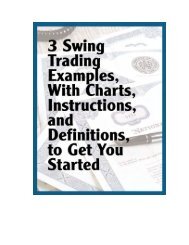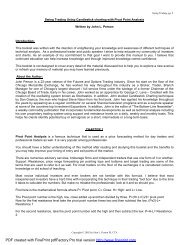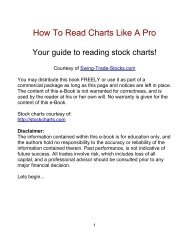To all those who did not dedicate - The Swing Trading Guide
To all those who did not dedicate - The Swing Trading Guide
To all those who did not dedicate - The Swing Trading Guide
You also want an ePaper? Increase the reach of your titles
YUMPU automatically turns print PDFs into web optimized ePapers that Google loves.
A Practical <strong>Guide</strong> to <strong>Swing</strong> <strong>Trading</strong> by Larry <strong>Swing</strong><br />
Notice in the chart below that the downtrend is interrupted by short-term r<strong>all</strong>ies<br />
(pull-ups). <strong>The</strong> trade is placed after a short-term r<strong>all</strong>y (or pull-up), once the stock<br />
resumes its downtrend.<br />
<strong>The</strong> trade is entered on a day when the price f<strong>all</strong>s below the low of the previous day.<br />
<strong>The</strong> rules for entering and exiting a short swing are shown schematic<strong>all</strong>y on the<br />
next page.<br />
While the rules might seem somewhat complicated, several brokerage firms make<br />
the process quite easy. Interactive Brokers – described in the next section –<br />
<strong>all</strong>ows you to enter the three components of the trade <strong>all</strong> at the same time. For a<br />
short swing they are:<br />
• A sell stop to sell the stock when the price moves below the stop price<br />
• A buy stop to buy back the shares if the price moves up 4%<br />
• A buy limit to lock in profits (on ½ the shares) when the price drops 7%<br />
<strong>The</strong> schematic diagram provides instructions for how to adjust these prices on the<br />
second day, third day, and so on, based on whether the stock has been sold short<br />
or <strong>not</strong>. <strong>The</strong> schematic provides exit instructions as well.<br />
Visit: http://www.mrswing.com/ or email: larry@mrswing.com












